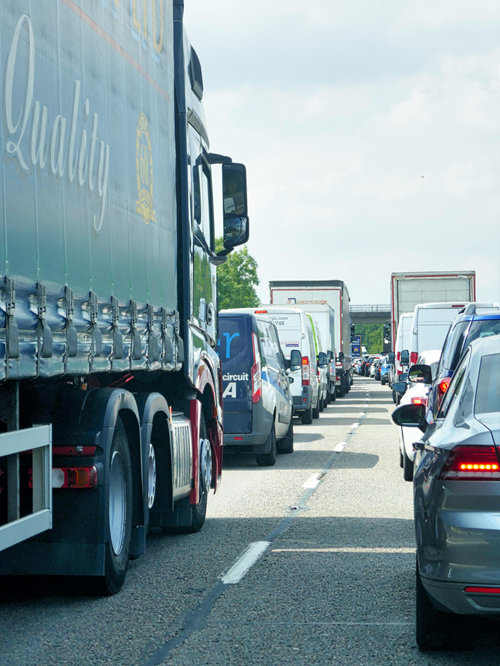
I’ve been driving passenger vehicles since 1979, and commercial vehicles since 1983. Over the years, I’ve developed a perspective of how traffic flow should be. I even developed a perspective of holiday traffic flow, which is much different than everyday traffic. For example, the Thanksgiving holiday is typically the highest travel day of the year. I learned to adjust my driving style and be extra vigilant during morning and afternoon rush hours, and holiday traffic. In general, you end up with a basic expectation of how traffic will be at different times of the day, and/or holidays like Labor Day weekend, Memorial Day, Thanksgiving, Christmas, and New Year's Day. An example would be New Year's Eve - this is a time that you have to be extra aware that you might be sharing the road with an impaired driver.
Of course, in a perfect world, everyone would drive in the proper lane at the proper speed, and never be impaired while they exercise their privilege of using our public highway system. However, we know that this doesn’t always happen. We have speeding drivers, reckless drivers, impatient drivers, impaired drivers, distracted drivers, selfish drivers, and these all combine to make traffic flow a difficult transition. We have vehicles that hang out in the passing lane, driving at a speed well under the speed limit, and at the same time other vehicles are traveling 20, 30, sometimes even more miles per hour, over the posted speed limit and passing (on the right) the vehicle that was traveling too slow. So which one is wrong? The driver who is on the left lane improperly? Or the driver who made the pass traveling 20 miles over the speed limit on the right? The answer to this question is: they were both wrong.
What I have noticed, and is why I titled this installment, “Please,” comes from my observation that traffic has really seemed to be getting more intense and aggravating over the last six months. At first, I thought, “oh well, maybe it's just me getting older and having less patience for people driving erratically”. What I decided to do, was to look up and see if there was data that supported what I was seeing. Because we all know, sometimes our perception can be deceiving, hence the old saying “Perception is reality”.
The newest data I could find compared the year 2019 to 2020. The two sources I found were a combined study by The Insurance Institute for Highway Safety (IIHS), The Highway Loss Data Institute (HLDI), and the National Highway Traffic Safety Administration (NHTSA). There were many interesting figures from these sources. From the IIHS, HLDI article, I found there were 33,244 fatal motor vehicle crashes in the United States in 2019, in which 36,096 deaths occurred. The end result was 11 deaths per 100,000 people, and 1.11 deaths per 100 million miles traveled. Another interesting figure from this article was the fatality rate per 100,000 people ranged from 3.3 in the District of Columbia to 25.4 in Wyoming. Also, the death rate per 100 million miles traveled ranged from 0.51 in Massachusetts, to 1.73 in South Carolina. I urge you to read this report and all of the numbers, as it puts it in good perspective, as to what’s happening on our highways today.
Next, I went to the NHTSA article on my Google search. The headline that popped up was “2020 Fatality Data Show Increased Traffic Fatalities During Pandemic” as their title and their teaser was “Risky Driving Behaviors Including Failure to Wear a Seatbelt, Speeding and Drinking While Driving Identified as Contributing Factors”. I felt somewhat relieved that the data supported what I was seeing and feeling, and that I wasn't becoming a cranky old man. What was seen was that Americans drove less in 2020, due to the pandemic, yet, there was the largest projected number of fatalities since 2007.
In 2020, there were an estimated 38,680 people who died in motor vehicle crashes. The fatality rate for 2020, was 1.37 fatalities per 100 million vehicle miles traveled, up from 1.11 fatalities per 100 million vehicle miles traveled in 2019. This is an increase of 23.4234%. In this article, which was published by the NHTSA, there was some good news as far as the trucking industry. There were few categories that had projected decreases in fatalities for 2020. Fatalities and crashes involving a large truck (commercial or non-commercial use), were projected to decline marginally by 2%. And fatalities amongst older people, 65+ years of age, were projected to decline by 9%. So, what do we do as we ply our trade on our nation's highway system, with the driving behavior becoming what it is today?
There seems to be less enforcement of highway laws, and more basic disregard for traffic etiquette, which brings me back to the title of this article, “Please”. What I’m asking is for everyone to share this message. When I say “Please”, this includes slowing down, signaling your intentions in traffic, not driving aggressively, driving in the proper lane, slowing down for construction zones, and in general, driving like we are in a civilized, organized society, and not the last lap of an automobile race. Let's get the message out there through our actions, and by sharing to our non-professional driving friends how this affects all of us. Until next time... “Please” Be Safe!